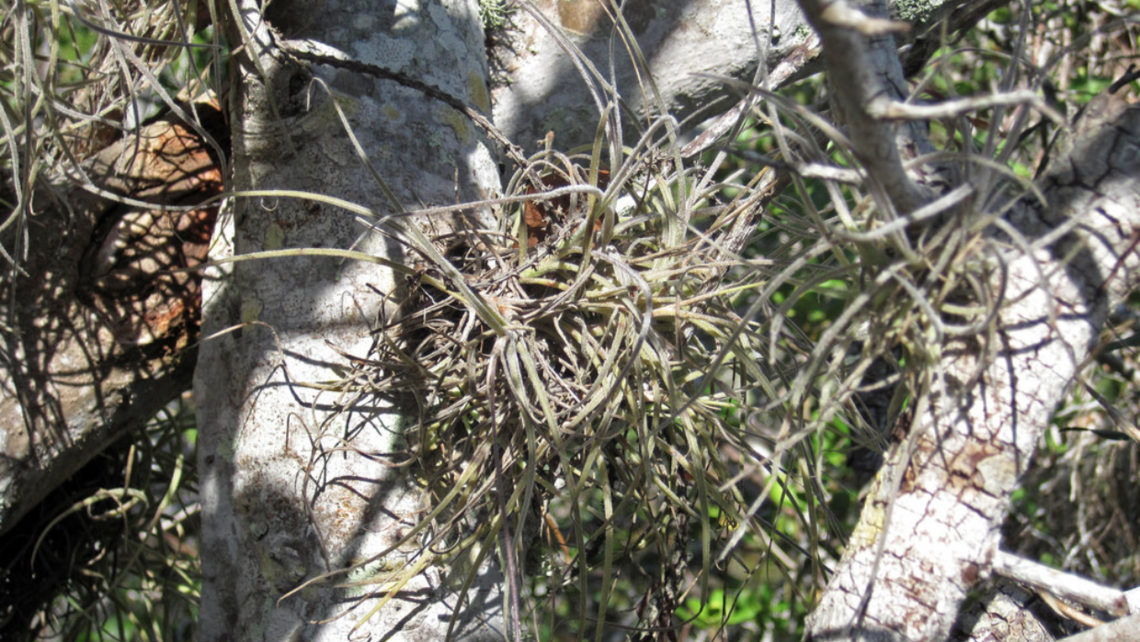
As often as I’m questioned about this particular plant, which is found so commonly in the trees of central Texas, I almost feel like I should apologize for not addressing it sooner. What follows is a definitive Q&A treatise on all things ball moss.
“What is ball moss?”
Tillandsia recurvate, or small ball moss, is an Epiphyte (air plant).
“What is an epiphyte?”
An epiphyte is not a parasitic plant. Rather, it adheres to its host (tree, fence wire, phone line, etc.) and obtains essential nutrients and moisture from airborne dust, organic litter, rain, dew, etc. that accumulates in its unique leaves and root system.
“Does it hurt the tree?”
Though it is not parasitic, ball moss does hurt the tree. It is a minor to moderate health threat for the following reasons:
- In cases of severe infestation, large quantities of ball moss that obtain multiple coatings of freezing rain can add so much additional weight to the tree that premature branch failure may result.
- When severe infestation occurs near the canopy tips of a tree, the ball moss will cover dormant plant nodes. As a result, these nodes are not capable of producing necessary new growth.
- Numerous insect pests can utilize the ball moss as a protective domicile or retreat spot to avoid natural predators like birds, lizards, and such.
- Bark often erodes under the ball moss, and rot can occur as a result.
- Ball moss lowers a tree’s monetary contributing value to the property. It can increase maintenance costs if removed infrequently. It is a very prolific progenitor (repopulates itself quickly). Any tree and plant appraisal conducted by an expert will require a reduction in the valuation of the trees on the property as a result of unmaintained ball moss populations. Such a reduction is in accordance with the formula followed universally by qualified consultants.
“But most of it is on dead branches…it is killing the branches, right?”
Actually, ball moss accumulates on dead branches after the fact. Inside the canopy of a big tree or group of trees, the very lightweight ball moss’s propeller-like seed loses speed and more easily adheres to rough surfaces like a dead branch, often bouncing off tree leaves and floating past them. In most cases, the branches died as a result of the tree phasing them out because those particular branches were not photosynthesizing enough on account of a lack of sunlight to the canopy interior. (Trees are extremely efficient when it comes to resource utilization). Humidity and more organic debris build up in this micro-climate, which results in higher germination, propagation, and all-around ball moss health.
“What should I spray it with?”
Never spray ball moss with an herbicide, sodium bicarbonate, or copper fungicides. All these methods of treatment harm the tree.
“What should I do about the ball moss?”
Remove most of it mechanically (pole saw, hand pick it, etc.) every three to five years (adequate in most cases). DO NOT let a tree contractor remove a lot of green leaves in order to remove all the ball moss. Leaves equal food production for a tree. Starving a tree in order to remove ball moss is never a good practice. Proper canopy cleaning (which includes some canopy thinning) will remove most of the ball moss and increase airflow through the canopy, both of which will decrease the amount of seeds, locations for attachment, and likelihood of attachment.



